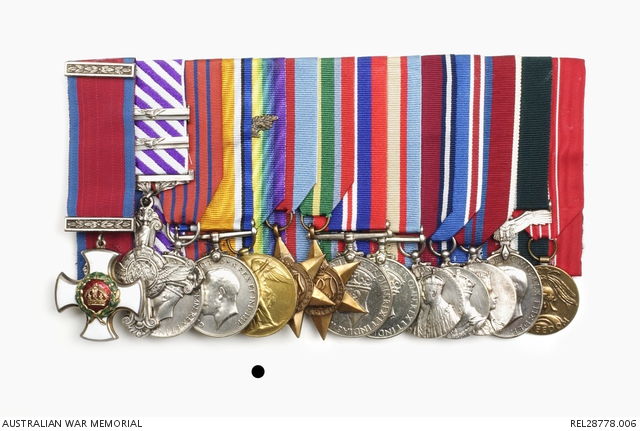| Place | Europe: Western Front |
|---|---|
| Accession Number | REL28778.006 |
| Collection type | Heraldry |
| Object type | Medal |
| Physical description | Bronze |
| Maker |
Unknown |
| Place made | United Kingdom |
| Date made | c 1920 |
| Conflict |
First World War, 1914-1918 |
Victory Medal with Mention in Despatches Oakleaf : Captain A H Cobby, 4 Squadron, AFC


Victory Medal with Mention in Despatches Oakleaf. Medal impressed around edge with recipient's details.
Associated with the service of Captain Arthur Henry 'Harry' Cobby. Cobby was born in Prahran, Victoria on 26 August 1894 and was a bank clerk on enlistment in the AIF on 23 December 1916. Cobby applied for, and received, a commission as a second lieutenant in the Australian Flying Corps (AFC), which was part of the AIF at the time. He had previously gained a commission as a second lieutenant in the militia, when he served with the 46th Infantry Battalion (Brighton Rifles) on 1 May 1914, before transferring to the 47th Infantry Battalion on 1 July 1915. Cobby embarked from Melbourne, Victoria, with 'A' Flight, 4 Squadron for England on 17 January 1917 aboard RMS Omrah.
Arriving at Plymouth on 27 March, Cobby was sent to Castle Bromwich for training. After learning to fly Sopwith Camels he arrived in France with 4 Squadron on 18 December. He shot down his first enemy aircraft on 3 February and by May, Cobby was an experienced combat airman, having flown against enemy aircraft and participated in low-level attacks against German troops during their March offensive. The latter, which subjected an aircraft to sustained ground fire, was a particularly dangerous undertaking. On 21 May Cobby shot down his first enemy observation balloon; like ground strafing, this brought a pilot dangerously close to ground fire. On 25 May 1918 Cobby was promoted to captain, having by now regularly led his flight on operations. By September Cobby had shot down 29 aircraft and 13 balloons, becoming the highest scoring ace in the AFC.
By the end of the war Cobby had been awarded the DSO and DFC with two bars, as well as being mentioned in despatches. Returning to England as an instructor Cobby was mentioned in Sir Douglas Haig's Despatch of 8 November for conspicuous service. He led the AFC fly-past over London on ANZAC Day 1919 before returning to Australia the following month. He was discharged from the AIF on 24 July.
On 31 March 1921, Cobby became a foundation member of the newly formed Australian Air Force. He was promoted wing commander on 1 May 1933 but left the RAAF on 6 May 1935 and became a member of the Civil Aviation Board and its controller of operations in March 1936.
On the outbreak of the Second World War Cobby rejoined the RAAF and was promoted firstly to group captain then to air commodore. He served in a number of capacities including Air Officer Commanding Headquarters North-Eastern Area. In March 1944 he was awarded the George Medal for his outstanding bravery in rescuing survivors of an air crash in which he had been involved as a passenger.
In April 1945 as Air Officer Commanding, 1st Tactical Air Force on Morotai, Cobby was presented with the resignations of several high ranking personnel who were annoyed at flying dangerous operations against what they considered 'senseless unimportant ground targets'. Known as the 'Morotai Mutiny', the episode resulted in Cobby being relieved of his command on 10 May.
On 30 November he was awarded the Commander of the Order of the British Empire by the Governor General at Government House, Melbourne. Post war, Cobby resumed his career in civil aviation and was appointed regional director, New South Wales, before becoming director of flying operations. He died suddenly on 11 November 1955 in Heidelberg Repatriation General Hospital and was accorded full military honours at St Mary's Church of England, Caulfield.
Related information
Conflicts
Events
Places
Subjects
People
Related Objects
- Group portrait of the officers of No. 4 Squadron of the Australian Flying Corps, at their ...
- Captain A. H. Cobby , DSO, DFC and two Bars sitting in the cockpit of Sopwith Camel fighter ...
- Portrait of Captain (Capt) Arthur Henry Cobby DSO DFC, of No. 4 Squadron, Australian Flying ...
- Group portrait of a group of officers of A Flight, No. 4 Squadron of the Australian Flying Corps ...
- Group portrait of officers of No. 4 Squadron, Australian Flying Corps (AFC), at their aerodrome. ...
- The officers of A Flight, No. 4 Squadron, Australian Flying Corps (AFC), in flying gear beside a ...
- Tail skid from a Pfalz D IIIa Scout shot down by Flying Officer A H Cobby, No. 4 Squadron, Australian Flying Corps
- Captain Arthur Cobby
- Talk by Air Commodore Arthur Henry Cobby about his service with the Australian Flying Corps during the First World War
- Commander of the Order of the British Empire (military division) : Air Commodore A H Cobby, RAAF